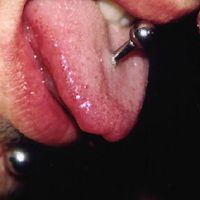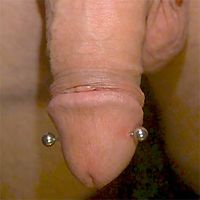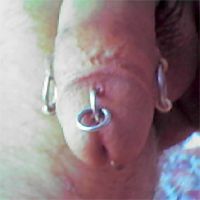







Anyway, I could go on and on. Most of the fear mongering bullshit surrounding piercing, even coming from professionals (doctors), friends, and parents, is simply not true. Feel free to ask BME questions, even if you think they're dumb.
Too often a piercer makes the claim that their kung fu is not only the best, but the only acceptable way of doing a piercing. If they do the piercing, it has to be done their special way or it won't heal right (at best). If the guru doesn't want to do it, it's because it'll kill you.
"If you don't do it in this gauge it won't heal"
"If you don't use this kind of jewelry it will reject"
"If you pierce it here you'll bleed to death"
"Without my patented aftercare it'll never heal"
...etc.
These piercings will not paralyze you. There aren't surface nerves with the capacity to do this -- if there were, you could pinch your ear or eyebrow and incapacitate yourself. Yeah, I know a friend of a friend yours had it happen to them. But they didn't. Doesn't matter what you do, you're not going to cause any serious damage from a little piercing like this. The human body just isn't that badly designed. 

Any tongue can be pierced. Too often I hear of piercers telling someone they can't have their tongue pierced because there are too many veins, or they can't stick their tongue out far enough. There's nothing wrong with admitting you can't do a piercing, but don't lie and say it's dangerous. A veinous tongue CAN be pierced, but it takes careful placement. A short tongue (well, one that's held inside the mouth by a frenulum that goes to the tip) CAN be pierced, but it's not easy, and takes a talented piercer. 
Large Vs. Small: They both work! Some piercers would have you believe that the only way to get acceptable healing from a piercing to pierce it in a large gauge. Another faction would tell you that's asking for problems, and to pierce it small -- after all, you can always stretch it later. The thing is, both ways work. You, as a client, should be most concerned with what YOU want as an end result. Not everyone wants a huge ring, and not everyone wants a dainty one. Either way, it's your piercer's responsibility to find out what you want, and get you there as safely as possible. 

You won't bleed to death. It doesn't matter what you do, you won't bleed to death from an ampallang. Most piercers will spend time attempting to figure out the location of the cavernosum (the part that fills with blood), operating under the delusion that if they nick it, you could bleed to death. Like I said before, the body just isn't that badly designed. The piercing on the right, above, goes right through the cavernosum, and in fact healed far faster than a regular one. I'm not saying this is the way to do it -- what I am saying, is get the piercing where you want it. 

Surface Piercing: The Fightstarter. There's probably more debate on the right way to do a surface piercing than any other type of piercing. Many will tell you that surface bars are the only way to make them heal. While it's true that surface bars are an excellent method, they're not the only method. That's one of the points that you need to understand about piercing -- there's never just one right way. Some piercers go even farther and make the statement that surface piercings shouldn't get done, because they're risky, dangerous, and/or don't heal. They're not risky -- worst case you have a small rejection scar, and while some don't heal, some do. As long as the client is informed as to the issues involved, have fun with it. 
Anyway, I could go on and on. Most of the fear mongering bullshit surrounding piercing, even coming from professionals (doctors), friends, and parents, is simply not true. Feel free to ask BME questions, even if you think they're dumb.